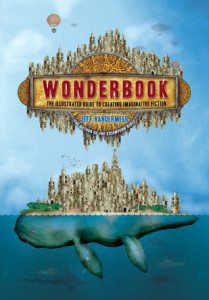
Written by Jeff VanderMeer and illustrated by Jeremy Zerfoss
Harry N. Abrams
ISBN: 978-1419704420
October, 2013; $24.95 PB
reviewed by K. H. Vaughan
This is not a book about horror, but so many of our Hellnotes readers are writers themselves that a review of the most exciting book on writing to be published in a long time seemed to me like a no-brainer. Wonderbook is a comprehensive examination of the writing process from inspiration to revision, written by award-winning writer, editor, and teacher Jeff Vandermeer. There are many good books on writing, but high-quality books aimed more specifically at writers of genre fiction are much rarer. Vandermeer does not suggest a single “correct” strategy or style, but describes a variety of alternatives and their advantages and pitfalls. He clearly knows his history and theory but is in no way pedantic or dogmatic. If anything, he makes a willful effort to offer ideas that run counter to advice just given, recognizing that the ultimate benefit to the writer is not to be found in following advice, but in struggling with it.
The text is jam-packed with strategies for attacking different aspects of writing. It unpacks the nuts and bolts of the process, offering a wealth of general guidance and specific techniques for creating better fiction. In addition to Vandermeer’s insightful discussion, there are frequent sidebars and essays from some of the best writers of imaginative fiction in the business. The text is rich in detail and generously enhanced with a variety of exercises and appendices. You could spend years mining the ore within and that doesn’t even touch the in-depth online content at the companion website wonderbooknow.com.
The book exudes a sense of whimsy and humor. A central thesis of the work is that although writing is hard work, it requires a core of play. Wonderbook is pervaded with a strong philosophical commitment to the unconscious as a critical aspect of creativity. Vandermeer encourages the writer to nurture that aspect of self, and to cultivate a working relationship with the powerful intuitive forces that underlie the process. The brain must be filled with interesting contents and given room to experiment with them. The finished product must ultimately be analyzed, polished, and edited, but the effective writer explores the absurd and unexpected freely.
The book also stands out because of its unique design, which features gorgeous illustrations by Jeremy Zerfross. The art is sumptuous, idiosyncratic, and beautifully intertwined with the text across the span of the volume. The illustrations serve to illuminate and expand upon the ideas in fascinating and effective ways. Writers spend a tremendous amount of time with the written word, and the most common advice offered to aspiring writers is to write and read. This makes good sense; you don’t learn the craft without hands-on practice. But most guides to writing are written in plain text, and no matter how good they are, they necessarily engage the lexical brain. Thus, our efforts to change our approach are filtered through the very process that we want to change. Wonderbook stands this model on its ear.
People often suggest editing in a different format than the one you write in as a way of breaking frame: editing on hard-copy if you use computer, changing fonts, even doing the editing in a different location. Anything to break set and allow you to see the work differently than you did when creating it initially. It is impossible to approach the content of Wonderbook in the same way one might simply read another book on writing. By engaging the brain in a more holistic fashion, and relating the linguistic to the visual, it creates a richer experience that should allow writers make new discoveries and see their work in a new light. Wonderbook is the only book on writing I am aware of that employs this technique to break set when thinking about the writing process itself. The luxurious and absurd imagery forces you to process the ideas in different ways than a more conventional presentation ever could. It is a brilliant and effective strategy.
Taken as a whole, Wonderbook leaves all others far behind in both its scope and in its commitment to a unique philosophy of pedagogy. This is a book that a writer will want to spend a long time with, rereading, tagging, and playing. There should be a copy in every middle and high school library, and it should be considered for college writing courses. Is it possible that part of my reaction is because this is the right book at the right time for me, personally? I suppose, but I doubt it. Although aimed at beginning and intermediate writers, even seasoned professionals who have enjoyed success will find something of value within.








